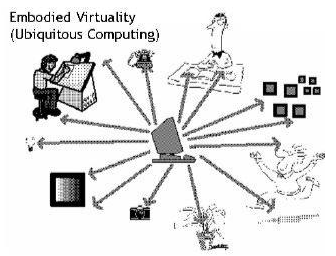



Faculty Mentor:
Ms. Disha Grover
Student Name:
Abhinav Satija (MCA-III)
Anubhav Berry (MCA-III)
1. INTRODUCTION
The word UBIQUITOUS refers to be found everywhere and anywhere. When this concept is applied to technology, the term ubiquitous means that the technology is everywhere and anyone can use it anytime simultaneously. Ubiquitous computing refers
to embedding computers and communication in our environment. It provides an attractive vision for the future of computing. This type of computing refers to availability and invisibility.
These invisible computers will not have keyboards or screens, but they will watch us, listen to us and interact with us. Ubiquitous computing environment involves the interaction, coordination, and cooperation of computing devices. The idea of ubicomp, i.e. ubiquitous computing, is to make a computer so imbedded, so fitted, so natural, that we use it without even thinking about it. The main goal of ubiquitous computing is to enable devices to sense changes in their environment, automatically adapt to environment and act based on changes based on user needs and preferences. Ubiquitous technology is often wireless, mobile, and networked, making its users more connected to the world around them and the people in it.
The prime objective of ubicomp technology is to make human life more simple, more safe and more efficient by using the ambient intelligence (electronic environment that are sensitive and responsive to the presence of people).
Similarly, Ubiquitous networking follows the idea of 4 A’s that are “anywhere, anytime, by anything and anyone” which is emerging as the core of newer technologies.

Fig 1: Ubiquitous Networking at a glance
2. WHAT IS UBIQUITOUS NETWORKING?
The concept of ubiquitous networking originated from the concept of ubiquitous computing, which was aimed at making many computers available throughout the physical environment, while making them effectively invisible to the user. Computers become a useful but invisible force, assisting the user in meeting his needs without getting lost in the way, and constructs a Universal
Computing Environment (UCE) that hides many embedded, wearable, handheld devices that communicate transparently to provide different services to the users based on requirement. Devices like these have a short range wireless communication capability and suffer with low power. They utilize multiple on-board sensors to gather
Information about surrounding environments.
3. UBIQUITOUS COMPUTING (UC) VS. VIRTUAL REALITY (VR)
Ubiquitous computing the complete opposite of VR as Mark Weiser said “VR brings the world into computers; UC brings computers to the world.
Basically he meant that the VR puts people inside a computer world but ubiquitous computing forces the computer to live in the world with people.


Figure 1: : Ubiquitous vs. Virtual Reality
4. UBIQUITOUS COMPUTING (UC) VS. ARTIFICIAL INTELLIGENCE (AI)
The term AI had not been associated with a commonly accepted, reasonably realistic definition, so that the association with human intelligence (or the human brain) was destined to lead to disappointments.
The AI hype has provided researchers with considerable funds but only for a while. Mark Weiser proposed to take a different approach towards a higher level of sophistication of computer based solutions (which had been the goal of AI at large). He considered it a more reasonable objective to concentrate on small subsets of intelligent behaviour and to dedicate each computer to such a subset.
Higher sophistication would be fostered by interconnecting the special-purpose computers and by making people cooperate. This reasoning lead to the term smart, considered more modest than the term intelligent. Sensor technology plays an important role in dedicating computers to a small subset of understanding the world around us (a key element of intelligent behaviour).
By widely deploying and interconnecting sensor-based tiny computers, one would be able to integrate environmental data (location, temperature, lighting, movement) and use this information to produce smart behaviour of computers and computerized physical objects.
5. LAYERS OF UBIQUITOUS NETWORKING
Following are the layers of Ubiquitous Networking:
5.1 Pervasive Network Layer
This layer includes all networks and the networks that are either connected directly or indirectly to the internet.
5.2 Pervasive Access Layer
This layer deals with the network connection issues that occur in pervasive network.
5.3 Pervasive Device Layer
This layer includes all user interactive devices whether they are interacted directly or indirectly.
5.4 Pervasive HMI Layer
This layer deals with Human interaction with all the network accessed devices.
5.5 Pervasive Human Core Layer
This is the inner layer of Pervasive Networking.
6. CHARACTERISTICS OF UBIQUITOUS NETWORKING
6.1 Permanency
The information remains unless the user purposely removes it i.e. the user can never lose their work.
6.2 Accessibility
The information is always available whenever the user needs to use it. System access via the ubiquitous computing technologies.
6.3 Immediacy
Information can be retrieved immediately by the user. Thus it saves user’s time and resources. Ubicomp makes it easier to share and get information.
6.4 Interactivity
The devices can interact with other devices efficiently and effectively through different media interfaces.
6.5 Context awareness and Adaptation
The system can adapt to the user real situation to provide adequate information for the user. The system can understand the user’s environment via database and sensing the user location, personal and environmental situations. It can adapt to Device Type, Time, Location, Temperature, Weather, etc.
6.6 Invisibility
It contains Invisible Intelligent Devices, Wearable Computing Devices, RFID, Sensors, Smart Card, Information Artefacts, and Tiny Smart Device.
7. DISADVANTAGES/ISSUES
It is not a long ago that this technology has been discovered. So, there are huge number of issues that need to be corrected to make the ubiquitous networking fully-functional to people. Ubinet is in its early phases
7.1 Privacy and Security
When such a vast number of entities are connected, their interactions and communications are examined more carefully. First, data from one person’s device must be distinguished from data from another’s. Second, it is necessary to ensure that false data is not intentionally injected by some other device. And finally, it must be rendered difficult or impossible to steal someone else’s data.
7.2 Information management
Billions of sensors generating petabytes of (dynamic) data which needs filtering, aggregation, collaborative sensing, new query techniques which cater for errors in source. Ubicomp must know how to modify the data and from where it should be modified.
7.3 Scalability
There are possibly thousands and thousands of devices that are part of scalability are a key requirement. The devices are independent and vmust be operated independently in a decentralized management which makes it more suitable to this environment.
7.4 Mobility
Mobility is made possible through wireless communication technologies. With wireless environment, there is a problem of disconnectivity. This behaviour is an inherent property of the ubicomp concept and it should not be treated as a failure.
7.5 Networking
Use of short-range wireless as well as traditional wired technologies together to conquer the ubinet entirely.
7.6 Reliability
The reliability of ubiquitous services as well as devices is a key requirement. Self-monitoring, self-regulating and self-healing like features might be a solution in order to construct reliable systems.
7.7 Interoperability
In order to make whole ubinet system work, it is necessary that the connected devices and sensors exchange their information with each other and make use of data.
7.8 Resource Discovery
The ability of devices to describe their behaviour to the network is a key requirement. On the other hand, it cannot be assumed that devices in a ubiquitous environment have prior knowledge of the capabilities of other occupants.
8. REFERENCES:-
1. https://www.researchgate.net/publica tion/290764350_Basics_of_ubiquito us_networking
2. https://www.slideshare.net/abhi9wag adre/ubiquitous-networking